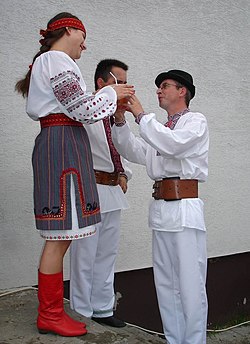This article has multiple issues. Please help improve it or discuss these issues on the talk page. (Learn how and when to remove these messages)
|
 Flag of Lemkos[1] | |
 Members of the folk group Osławianie from Mokre in original Lemko highlander folk-costumes | |
| Total population | |
|---|---|
| 75,228 | |
| Regions with significant populations | |
| 63,556 (2021)[a][2] | |
| 11,000 (2011)[3] | |
| 672 (census 2001) other sources - 350,000[4] [5] | |
| Languages | |
| Rusyn, Slovak, Polish, Ukrainian | |
| Religion | |
| Predominantly Ukrainian Greek Catholic or Eastern Orthodox, with Roman Catholic minorities | |
| Related ethnic groups | |
| Ukrainians, Boykos, Hutsuls, Rusyns | |
Lemkos (Rusyn: Лeмкы, romanized: Lemkŷ; Polish: Łemkowie; Ukrainian: Лемки, romanized: Lemky; Slovak: Lemkovia) are an ethnic group inhabiting the Lemko Region (Rusyn: Лемковина, romanized: Lemkovyna; Ukrainian: Лемківщина, romanized: Lemkivshchyna) of Carpathian Rus', an ethnographic region in the Carpathian Mountains and foothills spanning Ukraine, Slovakia and Poland.
Lemkos are often considered to be either a sub-group of Rusyns or Ukrainians or to form their own ethnicity. Members of these groups have historically also been given other designations such as Verkhovyntsi (Highlanders).[citation needed] Among people of the Carpathian highlands, communities speaking the same dialect will identify with a different ethnic label when crossing borders due to the influence of state-sponsored education and media. As well the same community may switch its preferred identification over time.[citation needed] In Slovakia between the 1991 and 2001 censuses, the number of people identifying as "Ukrainian" declined by 2,467 people (an 18.6% decrease) while those reporting Rusyn as their national identity increased by 7,004 people (a 40.6% increase). It is not clear however, if this refers to the same individuals switching their identification, more young first-time respondents choosing Rusyn, or migration.[6]
The spoken language of the Lemkos, which has a code of rue under ISO 639-3, has been variously described as a language in its own right, a dialect of Rusyn or a dialect of Ukrainian.[citation needed] In Ukraine, almost all Lemkos speak both Lemko and standard Ukrainian (according to the 2001 Ukrainian Census).[4] Ukraine itself categorizes Lemkos as an ethnic subgroup of Ukrainians and not as a separate ethnicity.[7] In the Polish Census of 2011, 11,000 people declared Lemko nationality, of whom 6,000 declared only Lemko nationality, 4,000 declared double national identity – Lemko-Polish, and 1,000 declared Lemko identity together with a non-Polish identity.[3] I.D. Liubchyk (І.Д.Любчик)[8] cites the number of 350 thousand Lemkos in Ukraine. During the population census in Ukraine in 2001, the majority of Lemkos called themselves Ukrainians.
- ^ Pilip, Milan (2014). Medviď, Peter (ed.). Русиньска народна сiмболiка [Rusyn National Symbology] (PDF) (in Rusyn, Slovak, and English). Svidník, Slovakia: Tlačiareň svidnícka. p. 92. ISBN 978-80-89755-03-5. Retrieved 23 January 2022.
- ^ "Number of population by ethnicity in the Slovak Republic at 1. 1. 2021". Statistical Office of the Slovak Republic. Retrieved 23 January 2022.
- ^ a b Przynależność narodowo-etniczna ludności – wyniki spisu ludności i mieszkań 2011. GUS. Materiał na konferencję prasową w dniu 29 January 2013. p. 3. Retrieved 2013-03-06.
- ^ a b 2001 Census
- ^ [ISBN 978-966-02-7999-5]
- ^ "Table 11. Resident population by nationality - 2001, 1991" (PDF). Statistical Office of the Slovak Republic. 2005. Archived from the original (PDF) on July 15, 2007. Retrieved September 15, 2017.
- ^ European Charter for Regional or Minority Languages
- ^ Dzjuba, Ivan Mychajlovyč, ed. (2016). Encyklopedija sučasnoï Ukraïny. Tom 17: Leh-Lošč / holovna redakcijna kolehija XVI tomu: Dzjuba, I.M. [und viele weitere]. Kyïv: Instytut Encyklopedyčnych Doslidženʹ Nacionalʹnoï akademiï Nauk Ukraïny. ISBN 978-966-02-7999-5.
Cite error: There are <ref group=lower-alpha> tags or {{efn}} templates on this page, but the references will not show without a {{reflist|group=lower-alpha}} template or {{notelist}} template (see the help page).